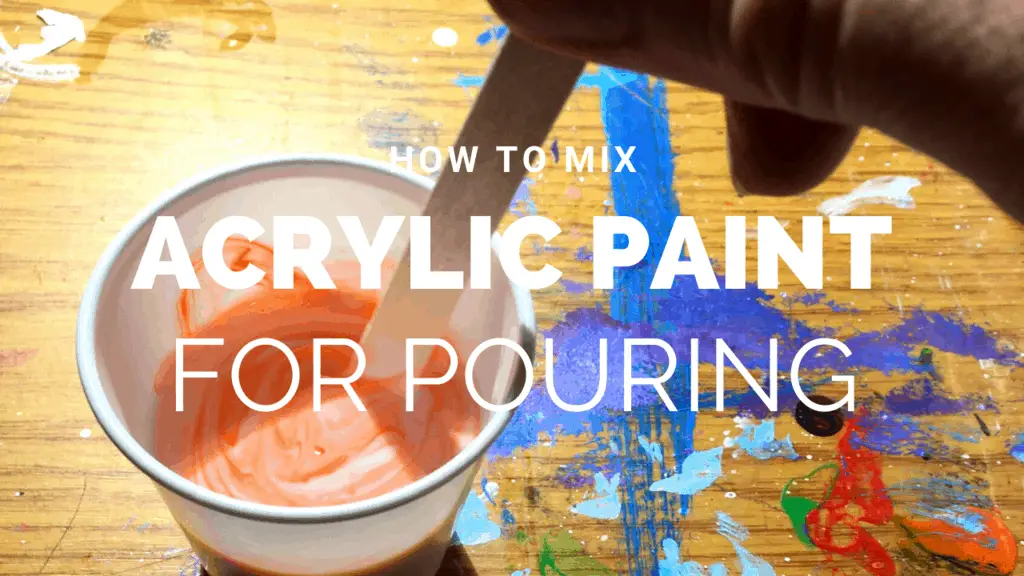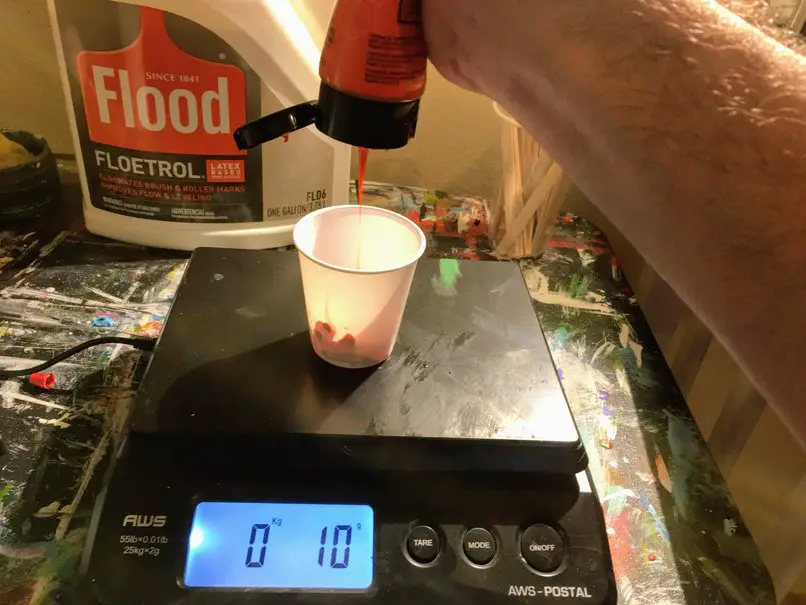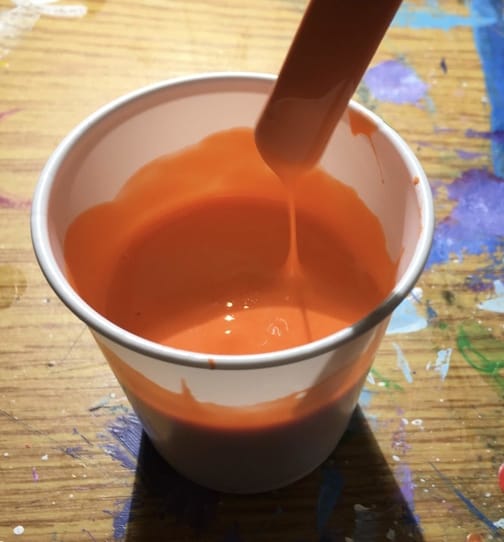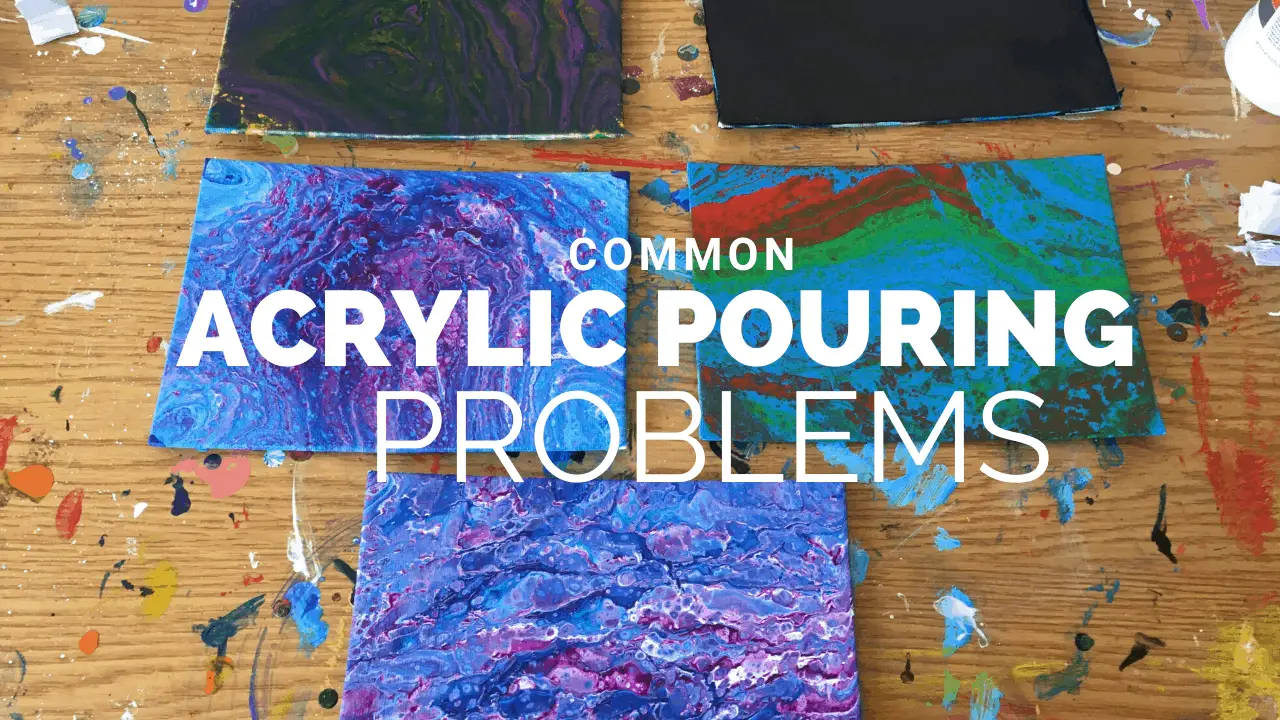
Learning how to do an acrylic pour can be a great way for any beginner to make great art pieces right out the gate!
Getting great results can take a bit of trial and error but I’m going to help reduce those potential errors right now.
While there are a ton of videos and content out there on acrylic pouring, they didn’t seem to help me avoid the many mistakes and frustrations I encountered in pursuit of quality results.
I have encountered numerous issues that I’m sure are common acrylic pouring problems for many of you as well. Click here to read more about these issues so you can better avoid them yourself!
I will soon be creating a whole series of additional pages and videos in the hopes of making it easier for you to get great results!
Here is a quick overview of the major steps in the process!
- STEP 1: Mix your paints with your pouring medium. The ratio you need to use depends on a variety of factors such as what type of paint you’re using and even what type of medium you’re using. There are a bunch to choose from and various ways to mix them. Pouring mediums and how you mix them are an integral part of the process of getting a great result.
- STEP 2: Decide what pouring technique you want to try. For your first pour I recommend a simple dirty flip cup. There are all sorts of different acrylic pouring techniques to try! Once you get some basic techniques down and understand how to mix your paints you can even create your own techniques!
- STEP 3: Prepare your paints. Deciding what technique to use makes the difference on whether you are going to put all your paints in one cup layered up, one cup layered slightly mixed or directly onto the canvas!
- STEP 4: Finally you pour your paint onto the canvas, tilt your paint around the canvas and watch the magic happen!!!!
The above steps give you a simplified birds-eye perspective. Before we explore them further, let’s talk about our ingredients next and see what all we will need to do our first pour.
Acrylic Pouring Supplies Needed

Before we get started lets gather up our pouring supplies and do some prep work.
When you first get started you don’t have to have all of what you see in the picture above. This is just a bit of what I have collected so far in pursuit of making great acrylic pours.
At the very minimum, you will need to get:
- Your preferred acrylic paints.
- Some canvasses to experiment with.
- Gloves if you prefer to keep your hands paint free.
- Cups to mix your paint in.
- Stir sticks to mix with.
- A pouring tray to catch excess paint.
- A scale or some other preferred measuring tool.
- Your pouring medium.
When I first started painting, I remember one of the first things I wanted to do was an acrylic pour. It seemed like an easy way to make a great piece of canvas art to hang on my wall.
This vision ultimately was my main motivation for picking up painting.
Rather than go to google with my queries I went to YouTube. I was looking for what I needed to get started.
I was also looking for the cheapest stuff too. Perhaps you are in the same shoes right now?
Only difference is you are actually smart enough to read a few articles instead.
I happened to come across a video recommending the use of Elmer’s glue and water as a pouring medium.
This worked okay for my first pour when I had absolutely no idea of what I was doing. Heck, I still had the paints from the little beginner acrylic paint set I first bought.
You may already have glue around as well which is what makes it a potentially good option for a first pour. If you have to go out to buy some though I would recommend buying Floetrol instead.
This the video I saw where the artist used glue as her medium.
Now, if you’re still new to this and you’re anything like I was you may not even fully understand what pouring mediums are. Well, they are pretty aptly named and do exactly what it sounds like they do.
I guess the easiest way to describe what a pouring medium is would be that it makes paint more liquid while helping the polymers stay intact.
Which ultimately prevents unwanted effects. Things like cracking and crazing.

It is important to understand these different effects that can happen to better understand how to avoid them or even use them to your advantage.
I believe it was Picasso who once said “Learn the rules like a Pro, So you can break them like an artist!”
When it comes to pouring mediums there are a number of popular mediums to try.
The most popular ones I have come across being used are Floetrol, Liquitex, Artists Loft and Glue.
If you want to start with glue follow the guidelines in the video above. For the recipe I will be showing you below, we will be using Floetrol.
I have been primarily focused on Floetrol for this article as it is easy to get in most places of the world and is pretty affordable too.
The next most important question to cover is how to mix your paints and mediums. This is where the real fun begins!
How To Mix Acrylic Paint For Pouring

The trick to getting a good poor is getting your paint mixture right. This can be a bit more challenging than it looks. Especially if you are looking to get that cellular effect that you see other people getting.
While I did my first acrylic pour using the glue and water mixture recommended in the video above I would recommend starting with Floetrol instead. A small bottle of it only costs around 6 or 7 U.S. dollars and it will be pretty easy to get good results with it. The larger one pictured here is $26.00.

My basic acrylic pouring recipe is to use 3 parts Floetrol to 1 part paint.
To measure that I like to use a scale that I happened to have lying around not being used. I measure that in grams.
I mix it with the Liquitex Basics brand of acrylic paint.
It took me a while to realize that this basic recipe will differ depending on the type of acrylic paints you are using.
I didn’t realize at first that in the YouTube videos I was watching they were using fluid acrylics and craft acrylics.
As a result when I tried to follow their ratios to mix my paint it ended up being too thick.
As with many of my early attempts at new things in the art world, especially with paint, I like to start with a small framed canvas. This way I conserve my resources while I make mistakes.

I highly recommend starting with small framed canvasses such as the 5 by 7 inch framed canvasses.
Even with proper research and information you are bound to make some mistakes. I hope to help you avoid that but it’s really part of the process.
This can be a very experimental art practice as that is where most of the creativity lies. In how you mix your paints and the techniques you use to put them on the canvas.
Plus with this size canvas, a small medicine cup is about all you will need for your pour!
The key to getting a good mix is understanding the proper amount of flow the paint should have once all mixed together.
This will be something you start to gain a sense for after doing a lot of pours.
I find that a 3 to 1 ratio is the best place to start with medium body acrylic paints like Liquitex Basics. If you have craft paints or something that isn’t as thick then start with a 1 to 1 or a 2 to 1 ratio.

This will get your paints fluid enough to flow while not so fluid that they run together and get muddy when you do your pour. Though sometimes that is a desirable effect.
Some people say it needs to be the consistency of honey which flows but tends to mound up as it hits the surface. This is a pretty good rule of thumb to go by.
Others say it needs to sit firm on the stick when you hold it horizontal and flow off when you tip it vertical.
I use a combination of all these plus I pick the cup up and tilt it around to see how well the paint flows imagining how easily or difficult it will be to flow across the canvas.
After doing a whole heap of these pours in the past couple of months I’m starting to gather an intuitive feel for it but I sill have much to learn.
I think a 2 to 1 ratio of Floetrol with Liquitex paint is still too thick but if you are feeling really timid and concerned about wasting paint it is always easier and cheaper to add more pouring medium than it is to add more paint.
I recently tried a pour using Liquitex pouring medium mixed with Liquitex Basics paint with a 3 to 1 ratio. The results and the flow of the paint were far too fluid.
In my next attempt to use Liquitex as my pouring medium I will definitely be starting with at 2 to 1 ratio instead.
This is just one example of how experimental this process can be. Various other things like altitude, temperature and moisture in the air can all have effects on your outcomes as well.
All of this should give you a basic place to start with your acrylic pouring adventures.

